First two turbines at the DLR research wind farm assembled
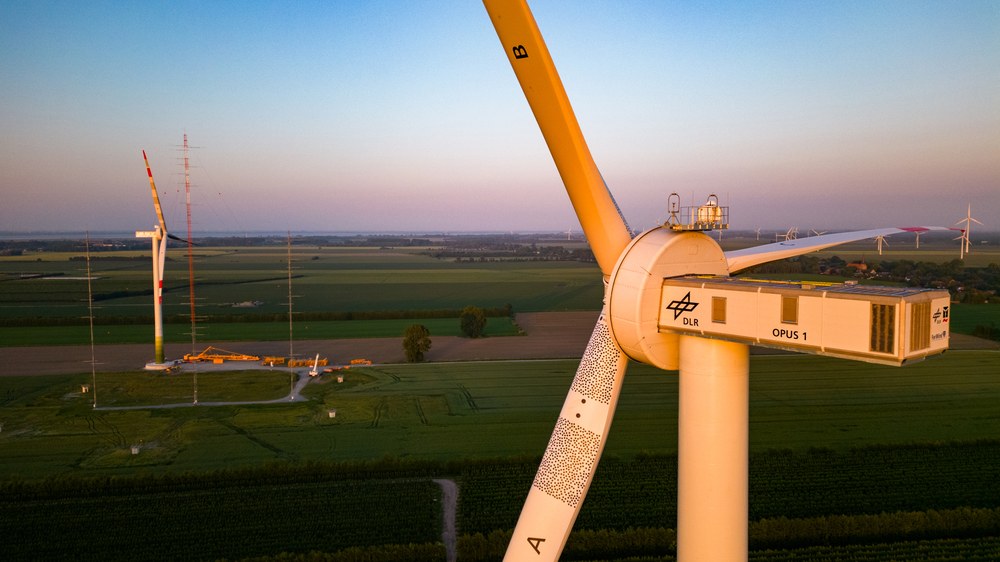
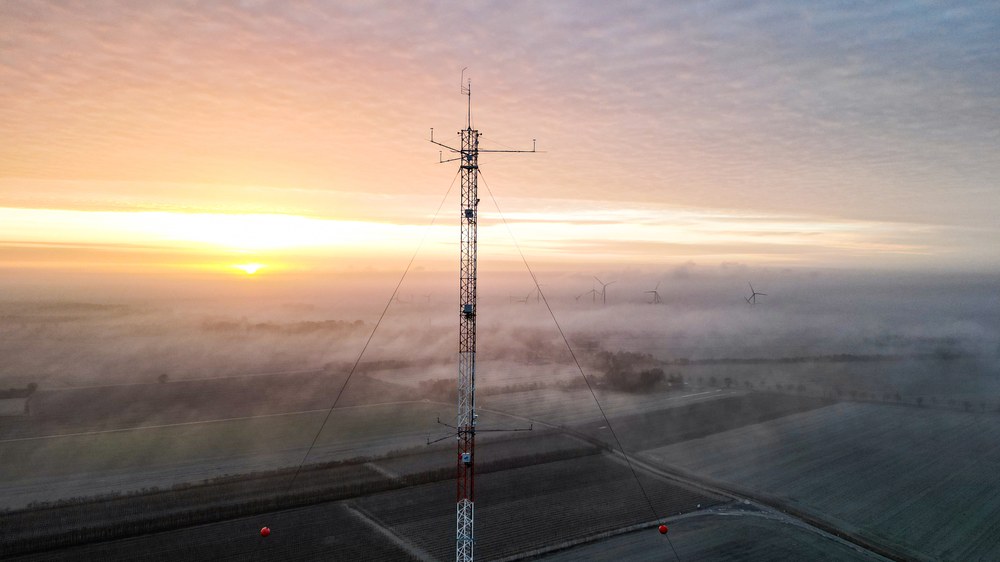
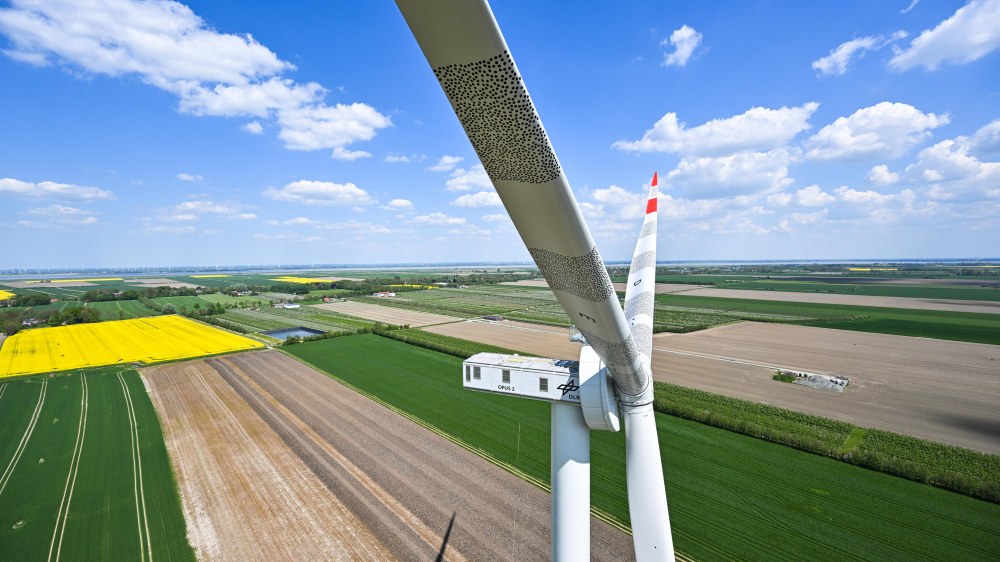
- The first two wind turbines of the DLR wind research farm WiValdi were completed in May 2023.
- With this unique large-scale research facility, DLR aims to make wind energy more efficient, more economical and quieter. This will also help to further increase acceptance of the technology.
- The WiValdi research farm enables full-scale research under realistic conditions and is open to industry and academia.
- Focus: Energy, wind energy, technology transfer
On the Lower Elbe between Cuxhaven and Stade – idyllically situated between fields and fruit trees – two German Aerospace Center (Deutsches Zentrum für Luft- und Raumfahrt; DLR) wind turbines have been in operation since May 2023. OPUS 1 and OPUS 2 reach 150 metres into the sky and are in good company. There are already several wind turbines in the vicinity spinning in the wind, which comes mainly from the west-southwest. They use this often-strong breeze to generate renewable electricity. At first glance, the two DLR turbines do not appear much different from their neighbours. However, up close it becomes clear: there is something different about them, starting with the many black dots spread over sections of the rotor blades. Then there are the nearby measuring masts, painted in bright red. Together with the control room, located a little further away, they form a very special ensemble: DLR's WiValdi wind research farm in Krummendeich.
Full-scale research – understanding the complete wind energy system
WiValdi stands for Wind Validation. The structure and composition of the large-scale research facility is unique. It was planned and implemented under DLR's leadership in cooperation with partners from the Research Alliance Wind Energy and from industry. Researchers will use the facility to determine and validate as precisely as possible how wind whirls through the two turbines of the research farm – down to the level of individual air molecules. "WiValdi enables us to do full-scale research under real environmental conditions. Our goal here is to better understand wind power as a whole with all its influencing factors," describes Jan Teßmer, head of DLR's Wind Energy Experiments facility, which is responsible for setting up and operating WiValdi. Based on these findings, DLR will then develop technologies to further increase the efficiency, cost-effectiveness and acceptance of wind energy – in collaboration with companies and other research institutions, which are also welcome to use the test field in Krummendeich.
From research to construction – a small team rises to the challenge
The official inauguration of the research farm is planned for August 2023. At this point, those involved will be able look back on an exciting and challenging time. It was a small team that was responsible for all aspects of this large-scale project: from planning the research farm, to coordinating construction processes and procurement, to communicating with the citizens in the surrounding communities. The DLR researchers had to develop entirely new areas of expertise and familiarise themselves with the local conditions and requirements. For example, they had to take into account the special requirements for building on soft marshland soil and measures to protect the surrounding orchards from soil erosion. "For us, this was something very special, far removed from the tasks of our everyday research," summarise Jakob Klassen, project manager, and Lukas Firmhofer, responsible for the timely construction of the third, smaller wind turbine, OPUS 3.
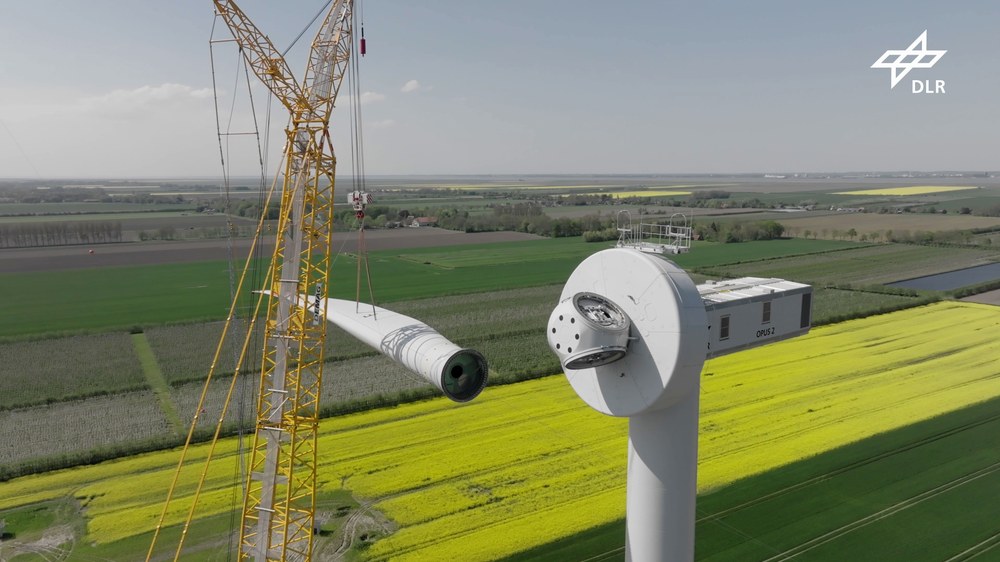
Video: Assembly of the rotor blades at DLR's WiValdi wind research farm
Your consent to the storage of data ('cookies') is required for the playback of this video on Quickchannel.com. You can view and change your current data storage settings at any time under privacy.
A handful of particularly daring volunteers from DLR trained to climb up measurement masts and turbines and, in the unlikely event of an emergency, to abseil down again using a rescue harness. This was essential for the occasional inspection of a sensor or testing of a measuring device. The project demanded strong nerves in addition to a love of wind energy: there were delays in the construction process due to the COVID-19 pandemic and the shortage of skilled workers. In order to inform the local inhabitants about the project and to track its progress, the team kept an online construction site diary (available in German) and organised site visits and informational events.
WiValdi rises into the North Sea breeze in under two years
The first scientific measurement campaigns started even before the construction work began. DLR researchers from the Institute of Atmospheric Physics collected extensive data using an optical, laser-based measuring device (lidar). From these data, they determined information on wind speed, wind direction and turbulence at the Krummendeich site that serve as reference and comparison values. The data allow for the detection of any changes caused by the wind turbines or to the local weather. Another important reference is the acoustic site assessment carried out by the DLR Institute of Aerodynamics and Flow Technology. This allows for any changes in the noise environment to be precisely analysed at a later date.
The first construction machinery arrived on the site in May 2021. In the following months, they built access roads and set-up areas for the cranes, foundations and cable routes for the power connection to the local energy supplier's transformer station. At the beginning of 2022, the first pile driving work for the establishment of the foundation took place. This was necessary for the safe construction of the heavy wind turbines and measuring masts on the soft marshland soil. In April 2022, the first measuring mast rose into the air. It stands at the western entrance to the research farm, is 150 metres high and equipped with over 100 sensors. It can measure the incoming wind at heights from the ground to the tip of the turbine rotor blade. The measuring mast array followed at the end of 2022. This construction connects three measuring masts, two 100-metre high masts located on either side of the farm and one 150-metre high mast in the middle. They primarily hold sensors developed by the ForWind partners at the University of Oldenburg. They determine exactly how the wind is eddied by the first turbine before it arrives at the second. Work began on the foundations for the wind turbines at the end of 2022, and in Spring 2023, the delivery of further components including tower segments, nacelles and generators took place. The container-shaped nacelle houses all the electrical components of the wind turbine. A lidar system is installed on the roof of the nacelle which measures the wind flowing into and out of the rotor.
The crowning achievement – assembly of the high-tech rotor blades
In April and May 2023, the time had finally come: the six rotor blades, all delivered by special transport over several nights, were now ready for assembly. The rotor blades were previously extensively instrumented during the manufacturing process over months of preparatory work and tested at the Fraunhofer Institute for Wind Energy Systems (IWES) in Bremerhaven. The DLR Institute of Aeroelasticity, the Institute of Lightweight Systems and the ForWind partners at the University of Hanover were involved in this process.
From the DLR team, to the crane operators and ground guides, to the workers who installed the blades in the rotor hub and fastened them with more than 50 bolts each, this last step was a very special challenge, while also the most exciting stage of the project.
Before the work could start, however, there was a lot of waiting to be done and nerves to keep calm. The lifting and mounting of the 57-metre-long, 20-tonne blades carried out using a large crane could only take place in good weather and, above all, calm wind conditions. If the wind speed was more than six kilometres per hour, which is very often the case at the site, no further work could be carried out. When the installation team decided it was time to lift the blades and attach them, it had to be done quickly. Once the blade was hooked, there was no turning back.
In the early afternoon of 13 May 2023, the work was complete: the second OPUS 2 wind turbine gleamed, fully assembled, in the early summer sunshine. In the weeks leading up to the inauguration in August, the team is now preparing the commissioning of the two turbines in close cooperation with the turbine manufacturer, Enercon. All the sensors that were previously installed for research in the individual components must now be wired and connected for use within the complete system. The DLR Institute of Flight Systems will ensure that the acquired data is stored in the synchronised data management system and is available to the users of the research farm. This will be followed by a period of trial operation and the installation of further measurement technology. The third, smaller wind turbine, OPUS 3, is to follow soon. It will have a modular design and thus be adaptable to different research experiments.
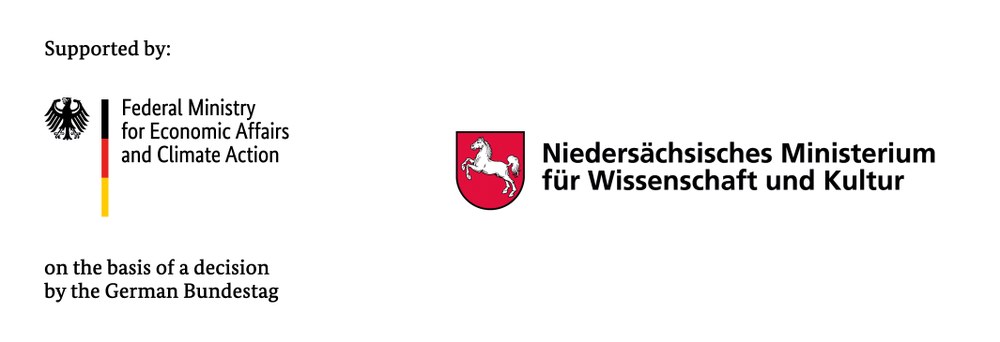
©BMWK, NMWK
